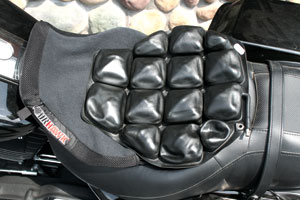 I’m cruising the aisles at the Americade vendor show, admiring all the farkles and widgets available to enhance anyone’s ride, and slow down as I go past the Airhawk exhibit. The company makes inflatable seat cushions that rest on top of a stock seat, and I was interested.
I’m cruising the aisles at the Americade vendor show, admiring all the farkles and widgets available to enhance anyone’s ride, and slow down as I go past the Airhawk exhibit. The company makes inflatable seat cushions that rest on top of a stock seat, and I was interested.
Harley had been kind enough to loan me a Road Glide Custom for the occasion, which I had picked up in New Jersey, ridden to Lake George, New York, and then would ride back to California. The stock seat was OK, but not great, and I thought I might have some discomfort on the 3,000-mile cross-country trip.
I am blessed with a relatively malleable butt, which adjusts to most stock seats, but while I can sit all day on an Electra Glide’s bucket, the stylish Road Glide saddle was a little sparser. And with the forward-positioned floorboards, I couldn’t stand up while cruising down the highway. A brief standing on the pegs is always good for relieving pressure on the posterior.
“Clem, you’ll love this;” said Steve, the Airhawk man, “it’s a real butt-saver on a long trip.”
“Tell me more,” I said, picking up the Cruiser Medium size.
He unzipped the cover and took out the neoprene insert. It has 14 separate but interconnected little air nodules, and a valve to get the air pressure right. “You don’t want it too stiff,” and he puffed it up until he was still able to compress four of the nodules flat. “What this does is gives your butt a slightly rolling sensation, the opposite of just sitting still. Too much air is no good and makes it too hard. Too little air, too much roll. You’ll find the perfect pressure.”
That whole gluteal region, better known as the buttocks—I looked all this up in Gray’s Anatomy—is a mess of muscles and nerves. And flesh, which is why some butts are so good to look at, others not so. Sit on a board for 10 hours, especially with the jouncing of a motorcycle’s suspension, and the muscles and nerves will complain; there is numb butt, and then there is pain butt—the infamous monkey butt. I’m usually good for two-, three-hundred miles before the pain begins, even on a less-than comfy saddle. But I was due for four- to five-hundred-mile days if I were to meet my schedule.
Steve said I could either strap the Airhawk to the saddle, or just lay it on top, as the bottom of the cover has a non-scratch but high-friction surface and stays put. I declined the straps. At the beginning I did kick the Airhawk off the saddle a couple of times when dismounting, but soon learned to lift my leg just a little higher.
After 3,000 miles I was quite glad to have had the Airhawk cushioning my glutes, rather like mini shock absorbers. I had one rainy day when I did not use it, and the difference was quite noticeable. Three hundred miles, my derrière is good. Four hundred plus, give me the Airhawk. I realize that a whole lot of gadgets are available in order to improve saddle time, from beads to sheepskins—and for all I know, inflatable underwear—but this Airhawk is the first I have tried, and it worked for me.
I like the fact that the Airhawk is available through parent company Roho as well as two respected catalogs, Whitehorse Gear and Aerostich Riderwearhouse—folks who know the good stuff. Price for the original Cruiser Airhawks, small, medium and large, is $190. I found that for high-mile days, it is money well spent.
For more information: Visit www.therohostore.com, or call Airhawk at (618) 277-9173








Couldn’t agree more. It makes all the difference on long days. I don’t leave home without it if I’m traveling more than 300 mi in a day.
Part of what makes the difference is that it lets air flow under a rider, thus keeping your rear end cooler.
Love my Air Hawk!